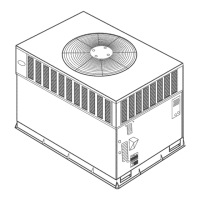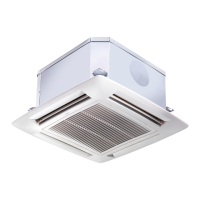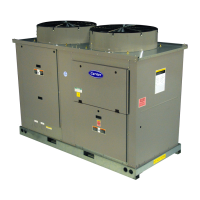21
energized until the low pressure switch closes and the anti--short
cycle time delay expires. If the low pressure switch opens 2--4
times in 1 hour, the unit will enter a 4 hour lockout period.
S ANTI-- SHORT CYCLE TIMER: 5 minute delay on break
timer to prevent compressor short cycling.
S RANDOM S TART: Each board has a unique random start delay
ranging from 30 to 270 seconds on initial power up to reduce the
chance of multiple unit simultaneously starting at the same time
after power up or after a power interruption, thus avoiding
creating large electrical spike.
S CONTROL FAULT: If the split geothermal unit control board
has failed, the control will flash the appropriate fault code (see
Table 15). The control board should be replaced.
S UPM DIP SWITCH SETTINGS: Th e UP M h as 3 features
controlled on the dip switch.
1. Freeze Protection Limit for the Freeze one water coil.
2. Lockout Settings (Soft Lockouts)
3. Brownout (High voltage protection)
DIP SWITCH
DIP Switch Position
ON OFF (Default)
SW1
Freeze Protection
Limit
15F 26° F
SW2
Number of Trips
to Lockout
(HPS / LPS)
4 2
SW3 Brownout
Brownout Protec-
tion is Disabled
Brownout Pro-
tection is Active
S FREEZE SENSOR: The water coil is protected by a thermistor
located between the condensing water coil (coax) and the thermal
expansion valve (see Fig. 9).
The setting is default at 26_F (-- 3.33_C) but can be changed for
un its w ith am p le ant i --freeze to h av e a low er setting o f 1 5 _F
(--9.44_C) with the dip switch selection or UI setting.
If the un it is emp loyi n g an op en loo p system (no anti --freeze
pro tection ), the freeze lim it trip fo r th e U I will on ly allow
selection of 26_F (--3.33_C) in order to shut down the unit at the
appropriate leaving water temperature and protect the heat pump
from freezing.
If the refrigerant temperature drops below or remains at freezing
limit trip for 30 seconds, the UPM will shut down the compressor
and the board will flash fault code 86 (FRZ1 lockout). Fault code
86 will remain until the condition is corrected and also requires a
manual reset low voltage circuit. After a manual reset and there is
a call for h eatin g, the u n i t will b e re --en ergized automatically
ON LY when th e freeze senso r tem p eratu re is 7_F (-- 13.9 _C)
above setpoint (SW1).
Fault code 57 is FRZ1 sensor fault, which means the sensor is
invalid, meaning the sensor could be open or faulty. If the sensor
is invalid or out of the range (the range is from --50_F to 150_F
(--45.6_C to 65.6_C), the compressor will be de--energized and
display the freeze sensor fault code (57). When the sensor goes
back into range, freeze sensor fault code will clear and the system
will start up automatically if a demand exists.
For troubleshooting the Freeze Sensor, r efer to Table 15.
A14121
Fig. 23 -- Freeze Pr otection Sensor Location
CAUTION
!
UNIT DAMAGE AND/OR OPERATION HAZARD
Failure to follow this caution may result in unit damage
and/or improper equipment operation.
If unit is employing a fresh water system (no anti--freeze
protection), it is extremely important to have the Freeze1
set to the default 26_F (--3.33_C).
CAUTION
!
UNIT DAMAGE AND/OR OPERATION HAZARD
Failure to follow this caution may result in unit damage
and/or improper equipment operation.
Freeze sensor will not guard against the loss of water . A
flow switch is recommended to prevent the unit from
running if water flow is lost or reduced.
S LOCKOUTS: If system protection faults occur, the unit will shut
down the compressor and fault codes will be shown on the UPM
board and the UI screen.
There are two types of lockouts:
Soft lockouts
-- This is a selectable dipswitch position to allow 2
or 4 unit trips before going to hard lockout.
Hard lockouts
-- Will require a manual reset.
This applies to all unit trips unless otherwise noted. In order to
exit the hard lockout early for servicing, the low voltage power to
the unit would need to be reset and the fault conditions corrected.
NOTE: The blower motor will remain active during a lockout
condition.
S BROWNOUT PROTECTION: The compressor will be shut
down if the incoming voltage falls below 170 VAC for 4 seconds
and fau lt co d e w ill disp lay on UP M LE D and wall control (if
applicable). The compressor will remain of f until the voltage is
above 173 VAC for at least 4 seconds and the anti--short cycle
timer times out.
Defeat the Brownout
-- The high voltage brownout feature can be
defeated in the event of nuisance trips due to severe noisy power
conditions. The UPM dip switch has brownout ON as default, to
defeat the brown out protection, the selection can be changed to
OFF. All efforts should be exhausted to correct any electrical
deficien cies befo re defeatin g this safety feature to eliminate
possible equipment damage.
S COMPRESSOR VOLTAGE SENSING: If there is no 230V at
the compressor contactor(s) when the indoor unit is powered and
cooling or heating demand exists, the appropriate fault code is
displayed. Verify the disconnect is closed and 230V wiring is
connected to the unit.
S 230V LINE (POWER DISCONNECT) DETECTION:The
control board input terminals labeled VS and L2 (see Fig. 22) are
used to detect co m p resso r v o ltag e statu s and alert the u ser o f
potential problems. The control continuously monitors the high
voltage on the run capacitor of the compressor motor. Voltage
should be present any time the compressor contactor is energized
and voltage should not be present when the contactor is
de--energized.
S CONTACTOR SHORTED DETECTION:Ifthereis
com presso r vo ltage sen sed w hen th ere is n o d eman d for
compressor operation, the contactor may be stuck closed or there
may be a wiring error. The control will flash the appropriate fault
code.
If the control senses the compressor voltage after start--up and is
then absent for 10 consecutive seconds while cooling or heating
demand exists, the thermal protector is open.
The control de-- energizes the compressor contactor for 15
minutes. The control Status LED will flash the appropriate code
shown in Table 15. After 15 minutes, with a call for low or high
stage cooling or heating, the compressor contactor is energized. If
the call for cooling or heating continues, the control will energize
the compressor contactor every 15 minutes. If the thermal

